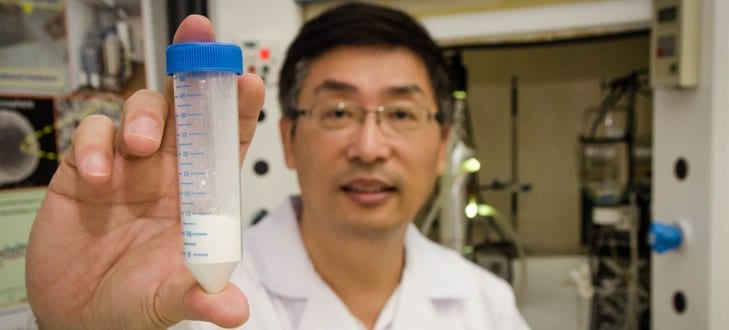
A new wonder material that can generate hydrogen, produce clean water and even create energy.
Science fiction? Hardly, and there’s more – It can also desalinate water, be used as flexible water filtration membranes, help recover energy from desalination waste brine, be made into flexible solar cells and can also double the lifespan of lithium ion batteries. With its superior bacteria-killing capabilities, it can also be used to develop a new type of antibacterial bandage.
Scientists at Nanyang Technological University (NTU), led by Associate Professor Darren Sun have succeeded in developing a single, revolutionary nanomaterial that can do all the above and at very low cost compared to existing technology.
This breakthrough which has taken Prof Sun five years to develop is dubbed the Multi-use Titanium Dioxide (TiO2). It is formed by turning titanium dioxide crystals into patented nanofibres, which can then be easily fabricated into patented flexible filter membranes which include a combination of carbon, copper, zinc or tin, depending on the specific end product needed.
Titanium dioxide is a cheap and abundant material, which has been scientifically proven to have the ability to accelerate a chemical reaction (photocatalytic) and is also able to bond easily with water (hydrophilic).
More than 70 scientific papers on Prof Sun’s work in titanium dioxide has been published in the last five years, the latest being papers published in Water Research, Energy and Environmental Science, and Journal of Materials Chemistry.
Prof Sun, 52, from NTU’s School of Civil and Environmental Engineering, said such a low-cost and easily produced nanomaterial is expected to have immense potential to help tackle ongoing global challenges in energy and environmental issues.
With the world’s population expected to hit 8.3 billion by 2030, there will be a massive increase in the global demand for energy and food by 50 per cent and 30 per cent for drinking water (Population Institute report, titled 2030: The “Perfect Storm” Scenario).
“While there is no single silver bullet to solving two of the world’s biggest challenges: cheap renewable energy and an abundant supply of clean water; our single multi-use membrane comes close, with its titanium dioxide nanoparticles being a key catalyst in discovering such solutions,” Prof Sun said. “With our unique nanomaterial, we hope to be able to help convert today’s waste into tomorrow’s resources, such as clean water and energy.”
Prof Sun’s multi-use titanium dioxide can:
1. concurrently produce both hydrogen and clean water when exposed to sunlight
2. be made into a low-cost flexible filtration membrane that is anti-fouling
3. desalinate water as a high flux forward osmosis membrane
4. recover energy from waste desalination brine and wastewater
5. be made into a low-cost flexible solar cell to generate electricity
6. doubles battery life when used as anode in lithium ion battery
7. kill harmful microbial, leading to new antibacterial bandages
The Latest Bing News on:
Multi-use titanium dioxide
- Single-Use Plasticson April 25, 2024 at 10:29 pm
Items: Single-use plastic water bottles up to a 1 liter, containers over 1 liter are considered multi-use and not part of the reduction for this order. Timeline: Immediate phase-out has begun. Unless ...
- Titanium Dioxide Color Market Competitive Research and Precise Outlook 2024 to 2032on April 18, 2024 at 10:47 pm
report_id=bw5345 Also, with the increased use of ultrafine particles of titanium dioxide in cosmetics and increased use of titanium dioxide as a photocatalyst, the adoption & demand for Titanium ...
- Did this cruise line actually ban Vaseline and my sunscreen?on April 18, 2024 at 6:00 am
One cruiser was surprised to find her favorite cosmetics on her cruise line's "do not pack" list. Could she keep the oceans safe while avoiding sunburn? Here's how she put the line's recommendations ...
- Global Titanium Dioxide Industry Outlook Report 2024: Capacities, Production, Consumption, Trade Statistics, and Prices 2018-2033on April 17, 2024 at 9:08 pm
Dublin, April 18, 2024 (GLOBE NEWSWIRE) -- The "Titanium Dioxide: 2024 World Market Outlook up to 2033" report has been added to ResearchAndMarkets.com's offering. The report comprehensively ...
- VNTRD Venator Materials PLCon April 17, 2024 at 3:30 am
The Titanium Dioxide segment offers titanium dioxide (TiO2), such as rutile, anatase, and ultrafine TiO2 products for use in coatings, printing inks, PVC window frames, plastic masterbatches ...
- Titanium Dioxide Nanoparticle Market Top Players, Revenue, Share, Future Trends, Size, Report and Forecast 2024 to 2032on April 16, 2024 at 11:28 pm
Titanium dioxide nanoparticles are manufactured worldwide in large quantities for use in a wide range of applications. It is naturally opaque and bright, which makes it useful for use in pigments, ...
- Mining And Refining: Titanium, Our Youngest Industrial Metalon December 5, 2023 at 6:45 am
ready for manufacturing use. Metallic titanium isn’t the only desirable product from the mining and refining of titanium ore. Titanium dioxide itself has hundreds of industrial uses, most of ...
- U.S. Silica (SLCA) Announces Launch of EverWhite Pigmenton May 18, 2023 at 11:00 am
This highly specialized substance can be used to partly replace or complement other inorganic white pigments, such as Titanium Dioxide (TiO2 ... Customers can use it on quartz countertops ...
- 9 Surprising Ways You Can Use a Swifferon February 28, 2023 at 4:00 pm
Want to get the most out of this multi-use product? These unexpected Swiffer uses will have every nook and cranny of your home looking clean. Swiffers are designed to trap dust and allergens ...
- Tiny tactics transform titanium dioxideon August 10, 2022 at 6:37 am
ISK is exploiting the nanotechnology revolution in the coatings industry to tailor titanium dioxide pigments on an atomic level. “One method we use is to add certain chemicals to the titanium ...
The Latest Google Headlines on:
Multi-use titanium dioxide
[google_news title=”” keyword=”multi-use titanium dioxide” num_posts=”10″ blurb_length=”0″ show_thumb=”left”] [/vc_column_text]The Latest Bing News on:
Titanium dioxide
- Digital Twin Helps Raleigh, N.C., Foresee, Combat Urban Heaton April 26, 2024 at 3:57 pm
The city, part of North Carolina's Research Triangle, is using a digital twin model empowered by GIS and artificial intelligence to plan for and address urban heat. It drives understanding of how ...
- New Strong Buy Stocks for April 26thon April 26, 2024 at 4:04 am
List today: Fuel Tech, Inc. FTEK: This company that provides multi-pollutant emissions control and water treatment technologies has seen the Zacks Consensus Estimate for its current year earnings ...
- Best Income Stocks to Buy for April 26thon April 26, 2024 at 1:15 am
Here is a stock with buy rank and strong income characteristics for investors to consider today, April 26th: Kronos Worldwide, Inc. KRO: This company that produces and markets titanium dioxide ...
- Do Powder Sunscreens Really Work? Here’s What Experts Sayon April 25, 2024 at 5:01 am
When it makes sense to use powder sunscreen, plus our favorites to try. Jxfzsy/ We basically live in the golden age of sunscreen. Less than 50 years ago we were stuck with just a handful of options ...
- Certain snacks, drinks could be banned in some states due to cancer-causing ingredientson April 19, 2024 at 12:44 pm
Several states are mulling the possibility of banning certain food additives after California prohibited the the manufacture, sale and distribution of dangerous chemicals.
- Titanium Dioxide Color Market Competitive Research and Precise Outlook 2024 to 2032on April 18, 2024 at 2:47 pm
For Instance: According to the US Census Bureau, the total construction value in April 2021 increased by 9.8% compared to April 2020. As per IBEF In Union Budget 2021, the government has given a ...
- Global Titanium Dioxide Industry Outlook Report 2024: Capacities, Production, Consumption, Trade Statistics, and Prices 2018-2033on April 18, 2024 at 1:07 am
The "Titanium Dioxide: 2024 World Market Outlook up to 2033" report has been added to ResearchAndMarkets.com's offering.The report comprehensively analyzes the impact of various factors on the market, ...
- Titanium Dioxide Nanoparticle Market Top Players, Revenue, Share, Future Trends, Size, Report and Forecast 2024 to 2032on April 16, 2024 at 3:27 pm
Report Ocean recently published a research report titled “Titanium Dioxide Nanoparticle Market” 2024 Forecast to 2032 Analysis by Market Trends.” This study delivers accurate economic projections, ...
- Mining And Refining: Titanium, Our Youngest Industrial Metalon December 5, 2023 at 6:45 am
Titanium is never found in the metallic state in nature, but rather as oxides like titanium dioxide (TiO 2), and as such is widely distributed around the world. Rutilated quartz from Minas Gerais ...
- Tiny tactics transform titanium dioxideon August 10, 2022 at 6:37 am
Today the main one is titanium dioxide — a naturally occurring compound that is extremely white and bright in its powdered form. Originally introduced as a safer alternative to white lead ...
The Latest Google Headlines on:
Titanium dioxide
[google_news title=”” keyword=”titanium dioxide” num_posts=”10″ blurb_length=”0″ show_thumb=”left”]










